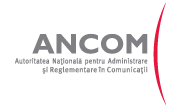Romanian DTH subscriber base shrank in 1H2010
Wednesday, December 8th, 2010
The Romanian electronic communications market in the first semester of 2010
The National Authority for Management and Regulation in Communications (Autoritatea Nationala pentru Administrare si Reglementare in Comunicatii) has published today, on its website, the half-yearly statistical data report on the Romanian electronic communications market in the first semester of 2010. According to the Report, the segments of fixed and mobile broadband Internet connections and voice/SMS traffic grew, whereas the number of subscribers to telephone (both fixed and mobile) services and to audio-visual programme retransmission services dropped.
The statistical data for the first six months of 2010 reveal that the Internet services registered the most significant upsurge, mainly due to the mobile Internet connections which grew by 26% up to 5.77 million. Among these, 3.32 million were mobile broadband connections (over EDGE/CDMA/EV-DO/3G), increasing by 31% compared to end-2009.
The number of fixed broadband Internet access connections rose by 4% compared to end-2009, up to 2.93 million. This escalation was almost entirely driven by the increase of the number of residential subscribers, who hold almost 90% of the total fixed connections. As per the support used, the largest share within the total fixed connections (more than 53%) is further held by the FTTB/FTTC/FTTN + UTP/FTP cable-type technologies.
The number of active users of mobile telephone services decreased by 4% in the first semester of 2010, down to 24.4 million, and the penetration rate of these services was 113.5% as of 30 June 2010. The structure of the users, by payment modality and category, is similar to that registered thus far, namely 67% are active prepaid SIM cards, and 33% are subscription-based SIM cards (23% for natural persons and 10% for legal persons).
Despite the downfall of the total number of users, the voice traffic in the mobile telephony sector kept growing, by 11.7% compared to the second semester of 2009, up to 25.5 billion minutes. The total number of calls rose by only 5%, and therefore the increase of the total traffic volume expressed in minutes is partly owed to the rise of the average length of a call, i.e. 2 minutes and 14 seconds (growing by more than 6% as compared to the previous semester). As well, the monthly average traffic per user intensified in each semester: 2 hours and 51 minutes as the voice traffic is concerned (+12%), respectively 27 SMS (+2%). This shows that the operators managed to adjust their offers to the current economic environment, both by cutting down their tariffs and by offering more traffic volume included in subscriptions/extra-options.
The Romanian users talk or send SMS messages mostly on-net, therefore this type of traffic holds the largest share within the total traffic achieved over mobile networks, as both voice traffic (86%) and SMS traffic (93%) are concerned.
The fixed telephone segment witnessed an evolution similar to that of mobile telephony, registering slight decreases in the number of subscribers and access lines concomitantly with slight increases of the traffic and average length of a call. Hence, the number of subscribers reached 4.04 million (-0.4%), whereas the access lines reached 4.68 million (-1%), and thus these decreases determined the decline of the penetration rates per 100 inhabitants (21.8%) and per 100 households (52.8%).
The traffic registered an increase by 0.4% compared to the second semester of 2009, as Romanians had talked for 3.75 billion minutes on their fixed telephone in the first half of 2010. The majority of users employ their fixed telephone for on-net calls (the on-net originated voice traffic holds approx. 62% of the total traffic), whereas the off-net mobile calls account for only 14% of the traffic. The average length of a call originated on the fixed telephone networks rose by 6 seconds, up to 3 minutes and 2 seconds.
The total number of subscribers to audio-visual programme retransmission services fell down to 5.73 million (-1.7%) in the first half of 2010, registering decreases as regards the number of both cable subscribers (-1.2%) and DTH subscribers (-3%). Although the number of IPTV subscribers grew highly (by 17 times per semester), these services hold only a 0.2% share within the total number of subscribers to audio-visual programme retransmission services.
Out of the 3.37 million of cable subscribers (with 46% penetration rate per 100 households), 2.62 million live in the urban area (66% penetration rate per 100 households), whereas 0.74 million live in the rural area (only 22% penetration rate per 100 households).
2.63 million subscribers receive digital audio-visual programme retransmission services by means of both cable networks (0.35 million) and DTH satellite networks (2.26 million), or IPTV (13,000). It is worth noticing that this semester witnessed the first decrease of the number of DTH subscribers (-3%), whereas the number of digital cable networks keeps growing (+10.5%).
The statistical data report was drawn up based on the data reported by the authorised providers of electronic communications networks or services, active between 1 January – 30 June 2010.
Latest News
- Barb to start reporting TV-set viewing of YouTube channels
- SAT FILM selects multi-DRM from CryptoGuard
- Qvest and ARABSAT to launch OTT streaming platform
- ArabyAds & LG Ad Solutions partner with TVekstra in Turkey
- Freeview NZ satellite TV service to move to Koreasat 6
- Comscore expands YouTube CTV measurement internationally
